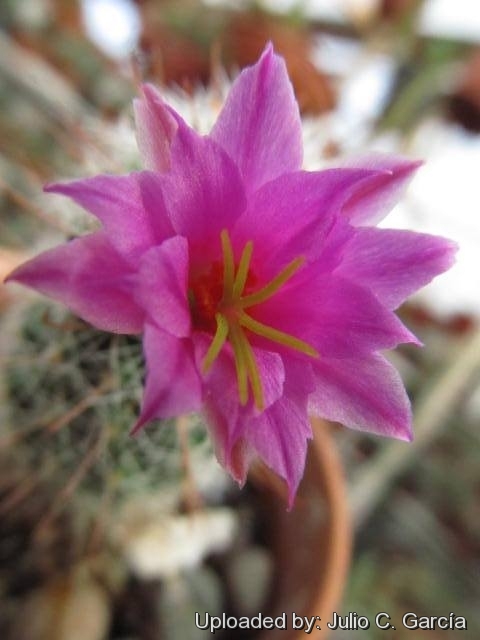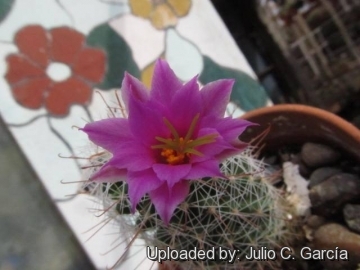Accepted Scientific Name: Mammillaria tonalensis D.R.Hunt
Cact. Succ. J. Gr. Brit. 41(4): 103–104 1979

Escobariopsis tonalensis (Mammillaria tonalensis) Photo by: Julio C. García
Origin and Habitat: Mammillaria tonalensisSN|23756]]SN|30214]] is endemic to the Tonalá Canyon in the north-west of the Mexican State of Oaxaca. All known collections are from the same area, which appears to indicate that it may have a very small range.
Altitude range: 1,000 and 1,400 metres above sea level.
Habitat and Ecology: The species grows in tropical deciduous forest, on vertical cliffs together with Mammillaria supertextaSN|19098]]SN|20905]], Mammillaria dixanthocentronSN|20905]]SN|19098]] and Mammillaria carneaSN|30214]]SN|23756]]. It lives in a relatively inaccessible habitat that does not appear to be under any threat, hence there is no apparent decline. This cactus is only grown by specialist collectors, and locally used as a remedy.
Synonyms:
Description: Mammillaria tonalensisSN|30214]]SN|30214]] is a small columnar cactus usually freely clustering from offsets with white radial spines and a single chestnut-brown hooked central. The flowers are carmine with whitish margins, but the plant is reluctant to produce its flowers unless the sunniest spot is found.
Roots: Fibrous.
Stems: Erect or sprawling, slender cylindrical, and ofsetting light green, to 12 cm or more high, 2-3.5 cm in diameter. Tubercles obtusely conical, axils naked or slightly woolly.
Central spine: One, hooked, chestnut brown, becoming dark with age, to 18 mm long.
Radial spines: 9-12, needle-like, straight, chalky white with brown tips, to 10 mm long.
Flowers: Carmine with whitish margins, to 15 mm long, 10-12 mm in diameter.
Fruits: Bright red.
Seeds: Black.
Bibliography: Major references and further lectures.
1) Cházaro, M. 2013. Mammillaria tonalensis. The IUCN Red List of Threatened Species. Version 2014.3. <www.iucnredlist.org>. Downloaded on 20 January 2015.
2) D.R. Hunt “Mammillaria tonalensis D. R. Hunt, species nova” Cact. Succ. J. Gr. Brit. 41(4): 103?104 1979
3) John Pilbeam “Mammillaria The Cactus File Handbook” Cirio Pub. Services, 01/December/1999
4) John Pilbeam “Cacti for the Connoisseur: A Guide for Growers & Collectors” Timber Press, 01 July 1987
5) Edward Anderson “The Cactus family” Timber Press, Incorporated, 2001
6) James Cullen, Sabina G. Knees, H. Suzanne Cubey "The European Garden Flora Flowering Plants: A Manual for the Identification of Plants Cultivated in Europe, Both Out-of-Doors and Under Glass" Cambridge University Press, 11/August /2011
7) David R Hunt; Nigel P Taylor; Graham Charles; International Cactaceae Systematics Group. "The New Cactus Lexicon" dh books, 2006
8) “Mammillaria tonalensis” Mammillarias.net <http://mammillarias.net> Web. 20 Jan. 2015.
9) Urs Eggli, Leonard E. Newton: "Etymological Dictionary of Succulent Plant Names." Birkhäuser 2004
10) Ulises Guzmán, Salvador Arias, Patricia Dávila: "Catálogo de cactáceas mexicanas." Universidad Nacional Autónoma de México, Mexiko-Stadt 2003
 Escobariopsis tonalensis (Mammillaria tonalensis) Photo by: Julio C. García
Escobariopsis tonalensis (Mammillaria tonalensis) Photo by: Julio C. García Escobariopsis tonalensis (Mammillaria tonalensis) Photo by: Julio C. García
Escobariopsis tonalensis (Mammillaria tonalensis) Photo by: Julio C. GarcíaCultivation and Propagation: Mammillaria tonalensisSN|30214]]SN|30214]] is easy to cultivate, and makes interesting specimens for any collection. Over time it will produce large clumps. It grows by producing offsets and doesn't require any special treatment.
Growth rate: Slow to offset and basically slow.
Exposure: It needs as much light as possible without burning the plant, to keep the stems compact.
Soil: It needs a well-drained soil mix.
Watering: Water well and then allow to dry thoroughly before watering again, during the growing season. Should really get no water in the winter
Hardiness: From tropical countries and pretty cold sensitive (listed most places as 10b-11, but seems to do OK in 10a). It can however can survive short exposures to light freezing temperatures (-4° C.) if properly hardened off and kept dry.
Propagation: It is best propagated from seed. Seed readily germinates at 20°-22°C, or by offsets if available.












